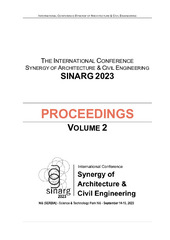Приказ основних података о документу
Towards Numerical Architectural Order Identification: Expressing Capital Morphology by Using Dynamics of Its Parameters
| dc.creator | Mitrović, Djordje | |
| dc.creator | Djordjević, Djordje | |
| dc.creator | Devetaković, Mirjana | |
| dc.creator | Djukanović, Gordana | |
| dc.date.accessioned | 2023-11-25T22:35:12Z | |
| dc.date.available | 2023-11-25T22:35:12Z | |
| dc.date.issued | 2023 | |
| dc.identifier.isbn | 978-86-88601-81-8 | |
| dc.identifier.isbn | 978-86-88601-82-5 (niz) | |
| dc.identifier.uri | https://raf.arh.bg.ac.rs/handle/123456789/1639 | |
| dc.description.abstract | Previous subject-related research, that describes stylistic peculiarities of artefacts by taking into account their morphometric/geometric characteristics, explicates the results (used to differentiate them in terms of style they belong to) mainly descriptively – by evaluating the obtained data visually. The narrower aim of this Paper is to explicate the mentioned characteristics numerically/quantitatively by transposing stylistic-wise parameters (descriptors of fractal and non-fractal nature), previously investigated by the actual authors, into the form of dynamics of their values namely explicators. Therefore, the main research questions of this study are both how to express artefact morphology by using dynamics of its parameters and, thus, how to numerically/quantitatively identify architectural style concrete artefact belongs to. To achieve that scientifically, a triplet of capital samples (as the most distinctive elements among artefacts), namely their digital 3D models, are employed per each fundamental classical architectural order (Doric, Ionic, and Corinthian). The subject of this Paper is to establish relevant morphometric/geometric indicators not only in the form of explicators mentioned above, but qualifiers too, enabling so: to numerically express capital morphology, namely to quantitatively estimate levels of intra-similarity of capitals assumed to belong to the same order, and inter-dissimilarity of those assumed to belong to different ones. Both types of the established indicators refer to capital contours which are positioned in mutually equidistant transverse section planes (defined per each chosen capital sample of each of the analysed orders). The wider research aim refers to both: (a) a possibility to numerically/quantitatively identify order a concrete fragment of capital/artefact belongs to in terms of recognising it computationally (as confidently as possible from the mathematical probability point of view), and (b) to perform morphology-wise capital/artefact segmentation. Presented innovative methodology brings up a more reliable possibility to identify architectural order “stylistically unknown capital” belongs to – by using a newly introduced indicator (in the form of dynamics) to express its morphology numerically/quantitatively. Future research will be dealt with software-wise automation of stylistic decoding steps (rough capital classification and order-belonging estimation). | sr |
| dc.language.iso | en | sr |
| dc.publisher | Niš : Faculty of Civil Engineering and Architecture, University of Niš | sr |
| dc.publisher | Niš : Serbian Academy of Sciences and Arts - Branch in Niš | sr |
| dc.relation | info:eu-repo/grantAgreement/MESTD/inst-2020/200090/RS// | sr |
| dc.rights | openAccess | sr |
| dc.source | Proceedings [of] The International Conference Synergy of Architecture & Civil Engineering, SINARG 2023, Niš (Serbia), September 14-15, 2023. Vol. 2 | sr |
| dc.subject | dynamics | sr |
| dc.subject | fractal object | sr |
| dc.subject | numerical stylistic analysis | sr |
| dc.subject | morphology-wise parameters | sr |
| dc.subject | classical architectural order capital | sr |
| dc.title | Towards Numerical Architectural Order Identification: Expressing Capital Morphology by Using Dynamics of Its Parameters | sr |
| dc.type | conferenceObject | sr |
| dc.rights.license | ARR | sr |
| dcterms.abstract | Деветаковић, Мирјана; Дјордјевић, Дјордје; Митровић, Дјордје; Дјукановић, Гордана; | |
| dc.citation.spage | 886 | |
| dc.citation.epage | 897 | |
| dc.identifier.fulltext | http://raf.arh.bg.ac.rs/bitstream/id/5298/bitstream_5298.pdf | |
| dc.identifier.rcub | https://hdl.handle.net/21.15107/rcub_raf_1639 | |
| dc.type.version | publishedVersion | sr |

